I was born in April of 1979, three months before the Atari 2600 was released and leading into the four years (1978-1981) regarded as the Golden Age of video gaming, allowing the industry to hone its skills and put that red-buttoned, stiff joystick in my capable, chubby hands at an early age.
Video gaming and I grew together: after that first Atari 2600 came the Atari 5200 during Elementary School, the original Nintendo in Junior High, followed by the Sega Genesis in High School segueing into college and ending my run with the original PlayStation as I started my first job in the U.S. until three years ago when lack of time and adult responsibilities forced my surprisingly tireless and dexterous fingers to retire from gaming. A move that both Bryony and my bank account are grateful for as consoles become more expensive and time-consuming, all the while evolving into furious technology, marketing and economic battles between the leading consoles: Sony’s PlayStation and Microsoft’s XBox. A barrage defined by the two giants’ discreetly changing Jekyll and Hyde personalities. Console wars are nothing new but it hasn’t been until now that they have gotten, literally, bloody.
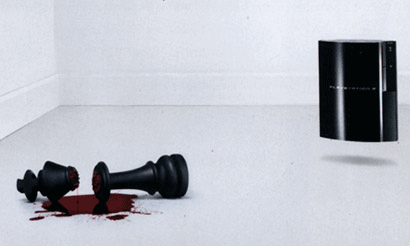
Detail of PlayStation 3 ad. [See full ad]
Rivalries between consoles have been ping-ponging since the late 70s: Atari vs. Intellivision, Nintendo Entertainment System (NES) vs. Atari; Sega Master System vs. NES; Super Nintendo vs. Sega Genesis vs. TurboGrafx 16 vs. Atari Jaguar; PlayStation vs. Nintendo 64 vs. Sega Dreamcast; Playstation 2 vs. Nintendo GameCube vs. Microsoft Xbox; and the latest, Playstation 3 vs. Nintendo Wii vs. Xbox 360. Plus a number of console flops and distractions and excluding the portable gaming market. Having cold-turkeyed from my video gaming addiction I am happy that I don’t have to worry about which console I’ll drop hundreds of dollars on or which advertising campaign I’ll be swayed by as both the PlayStation and Xbox market rather aggressively with print and outdoor campaigns, both of which I see regularly in magazines, blogs and TV as well as in the streets (New York’s scaffolding-per-capita puts hundreds of bigger-than-billboard ads at first-floor level) and with the Holiday Season upon us, both companies have gone into advertising overdrive bidding for console supremacy. What’s interesting (to me, at least) is not how fast their processors have become, how much storage capacity they provide, nor how web-connected and wireless they have grown but, rather, how PlayStation and Xbox have Foxtrotted to switch their personalities.
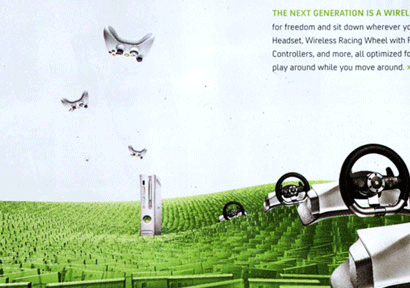
Detail of Xbox 360 ad. [See full ad]
The PlayStation and the Xbox have exchanged a simple premise: Black and White / White and Black. In literal and metaphoric ways. First, the literal. The original PlayStation ruled the late 90s with that light gray clunky box, big power and open buttons and vibrating controllers sitting under TV sets around the world. High Design it was not. Instead, it thrived in its simplicity and calm dominance of the market. Then in 2001, Microsoft, a company with no legacy or history of major hardware or entertainment development launched the Xbox: A scary, X-marks-the-spot, black console with black controllers, radioactive green accents and a logo that would swallow you whole as soon as you turned your back on it. The Xbox was everything the PlayStation was not — except a bestseller . The Black vs. White battle had begun.
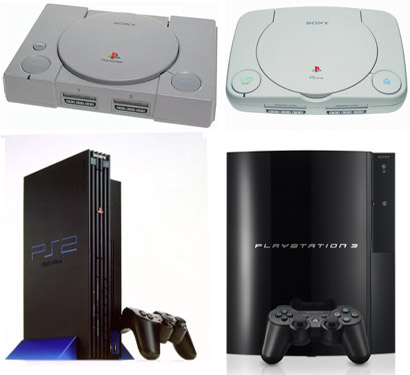
From White to Black: PlayStation, PSOne, PS2 and PlayStation 3.

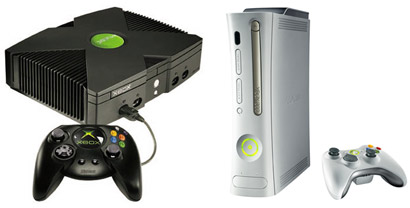
From Black to White: Xbox and Xbox 360.
Almost at the same time, the PlayStation 2, matching the Xbox in power, was released in an all-black dress code with haunting shades of blue and a futuristically minimal PS2 logo. Sony also released the PSOne, a revised (and cheaper) version of the original PlayStation with a more bubbly design, a white casting and overly friendly logo. The PS2 sold more consoles, but Xbox gained more souls. In 2005, with a strong following, Xbox introduced a sleek, white version of its console now labeled Xbox 360. The shocking black personality was now replaced by a confident, technically advanced simple design. More than a year behind its promised ship date, the PlayStation 3, finally premiered this November with a black, curvaceous design and a Spidermanesque logo. (Damn you Bronzo!). With the physical White and Black / Black and White metamorphosis complete within the span of a decade, the two consoles have also modified their attitude.
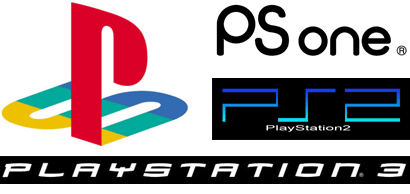
PlayStation’s identity moves into the future.

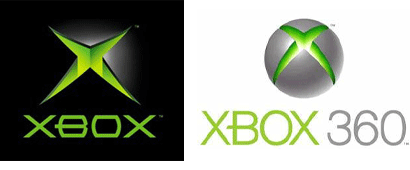
Xbox softens its edges.
While the hardware changes are obvious and objective, the Xbox and PlayStation have also played with the metaphor of White and Black — inherent in this is contrast. And in the console wars it has played out as a battle of good vs. evil, friendly vs. aggressive, pleasing vs. shocking. When the Xbox was introduced to the market it relied on shock and awe. The X in the name instantly made it “extreme”. The rumbling from the confines of the earth of the logo animation in TV advertising made it clear that this was a dangerous instrument of mass entertainment. The Xbox shipped with one of the most successful first-person shooters, Halo: Combat Evolved, relying on the success of multi-player violent games like Unreal Tournament played giddily by an army of man-children in offices across the world during the dot-com bubble. As a whole, Xbox was clearly positioned as Black to PlayStation’s White. With a limited number of titles for the Xbox, and a majority of them violent — quick disclosure: I don’t mind violence in video games and I don’t condemn it, I basically adored Mortal Kombat’s fatalities — the Xbox had a hard time competing with PlayStation’s stronghold on the market, but as more developers started porting games to the Xbox, the gap closed and the launch of Xbox Live (allowing users to play online and download additions to existing games) proved that Microsoft belonged in the market and that it had muscled its way in. With plenty of games in common between the PS2 and the Xbox, it was time for the next move. For both consoles.
With the launch of the PlayStation 3, Sony went Black. Its ad campaign, Play B3yond, revolves around a creepy PS3 mysteriously floating in a white room — reminiscent of solitary confinement in a psychiatric facility — that enjoys decapitating chess pieces, flooding rooms in black ooze and hypnotizing lifeless baby dolls. Other ads introducing the campaign featured a very scary depiction of Rock Paper Scissors and extreme versions of monkey bars and swings. Meanwhile, Xbox 360 decided to wear White. Their TV and print ads feature light settings with jolly flying green game boxes and touting the wireless accessories all floating happily around and above the Land of Xbox. A stark contrast to 2001’s launch. Worth noting is that Black has been the positioning of choice for Sony and Microsoft when the stakes were higher (and sharper) for each company. In 2001, Microsoft was betting $4 Billion on the Xbox and knew that it had to make an impact: It chose Black. In 2006, Sony, who was delivering the PS3 late (and also betting the house in its success) and losing market share to the Xbox, realized that it had to make a statement: It chose Black. In contrast, White has been used by both companies, in intervals, to signal confidence and leadership.
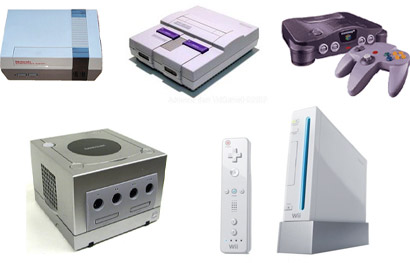
From gray to vanilla Nintendo keeps it in-between: Nintendo Entertainment System, Super Nintendo, Nintendo 64, Nintendo GameCube and Nintendo Wii.
Few industries feature such sharp contrasts in attitudes between competing brands and even more rare is the case where leaders exchange personalities. Apple vs. the PC market may be the most clear battle of cool vs. uncool but the chances of a flip-flop are minimal, specially with such a nebulous enemy for Apple; Pepsi vs. Coke, Nike vs. Reebok, Cingular vs. Verizon vs. Sprint, Paris Hilton vs. Lindsay Lohan, Prada vs. Gucci… All competitive brands operating between safe shades of gray with small and gradual changes in tone and volume. Perhaps it’s the inherent competitiveness, kill-or-be-killed state of mind and non-stop evolution of video gaming that is reflected in both manufacturers and buyers that allows such opposite leaps to be taken. Successfully. Unlike carbonated cola drinkers or Mac geeks where switching is rarely an option, gamers fluctuate to where the action is faster, harder and louder making it a no-brainer to switch to the console of the moment or, heck, play all the consoles of the moment further loosening the market and almost restarting the race with every new game, new mod, new console, new accessory. Watching these two brands morph, adapt and evolve (and fight it out!) is as enthralling as seeing two sticks bounce a ball across the screen for the very first time.

